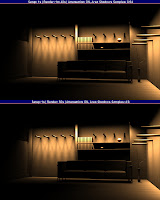I usually do interior renderings. This means that I use a lot all the cpu-killing bells and whistles available: glossy materials, area shadows, ies lights, GI etc. I have to render at 4k size or even more, so, in order to keep rendertimes as low as possible, I've learned to use a few tips.
- Glossy materials
Almost every material, in real life, is both reflective and bumpy. Obviously some material's reflections and/or bumpyness are so slightly noticeable that you can reproduce their aspect with a lot of workarounds and tricks. B2 material's glossiness itself is a trick - a trick to visually render the material roughness without having to use a bump or displacement map.
In my scenes I use a lot of glossy materials, almost 80% of the scene objects. So optimization for me is a must.
B2 glossy reflection default values could be too high in a lot of situations. I usually tweak the adaptive sampling Max Error, 'till I reach a good quality/speed compromise.
Default is 0.01, if possible I rise it to 0.05 - 0.2 , depending on the scene.
- Lot of lights
Ever had a scene with lot of lights, maybe with area shadows? A scene setup like this can easily kill your machine - and your rendertimes. Luckily, there's room for speed improvements, without sacrificing quality.- Attenuation
Turn on "attenuation" in your B2 light's feature panel. Then scroll down to the attenuation panel. I usually keep the defaults ("cubic spline", "Far" attenuation only), then I tweak the "Far" ranges - usually I raise the "start" radius until the attenuation "sphere" intersects the floor, and a little bit more for the "end" radius.
Original scene by Robert Boothman. 39 B2 Ies Ligths with Area Shadows.
Then I do a sample rendering, to check if the rendering aspect is similar to the one without lights attenuation. Here's the result:
- Area Shadow Samples
I used B2 ray shadows set to disc area, and left all the default settings except for Disc Area Diameter. The area shadows min/max samples are, by default, 8/64. I've used very low settings instead, 4/8. In order to make a comparison between higher and lower area shadows samples, I added some cylinders on the walls, used B2 render pass to temporarily substitute the scene materials with a grey plastic, and raised the AA settings to 0/2. Here are the comparison images (I did also a closeup near the cyilinders):


- Attenuation

